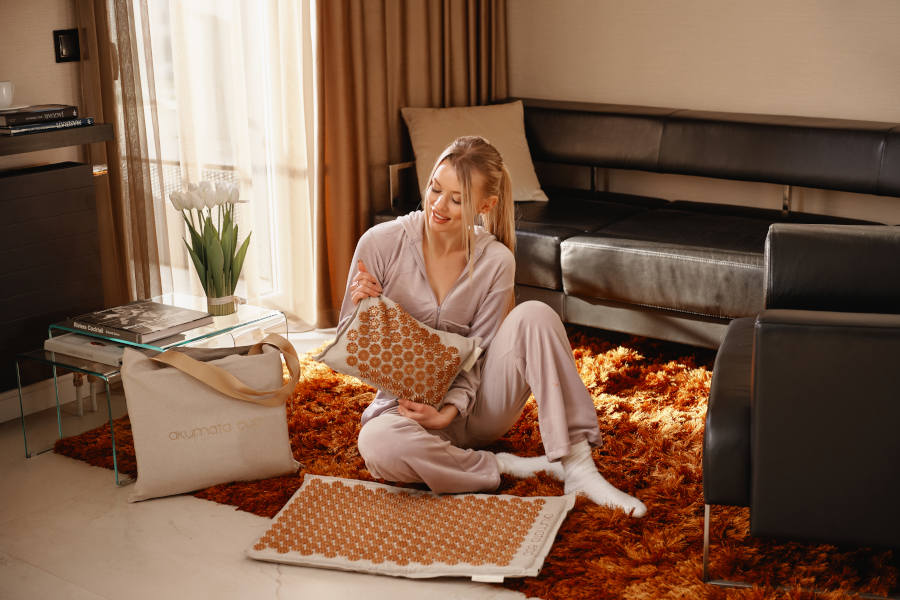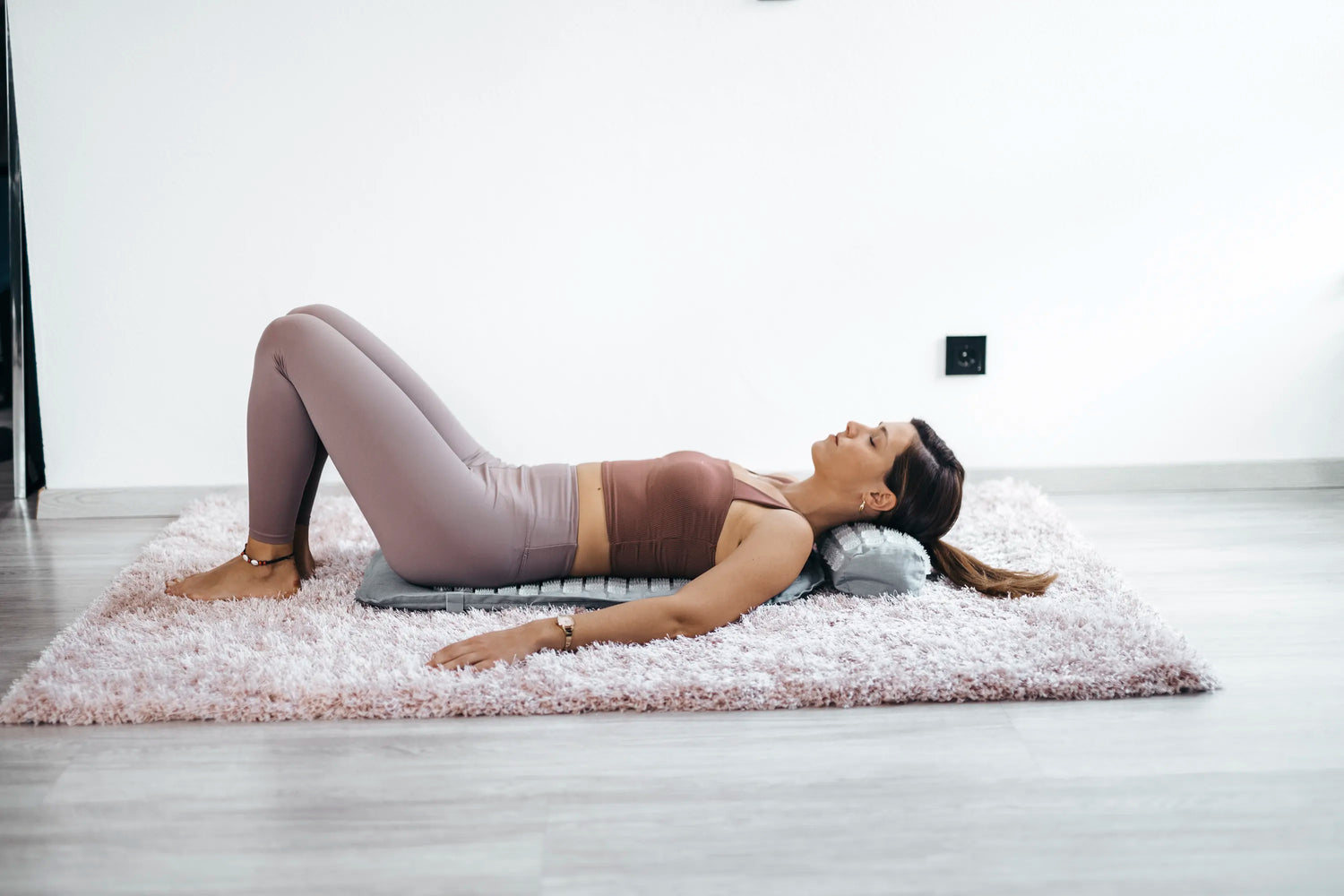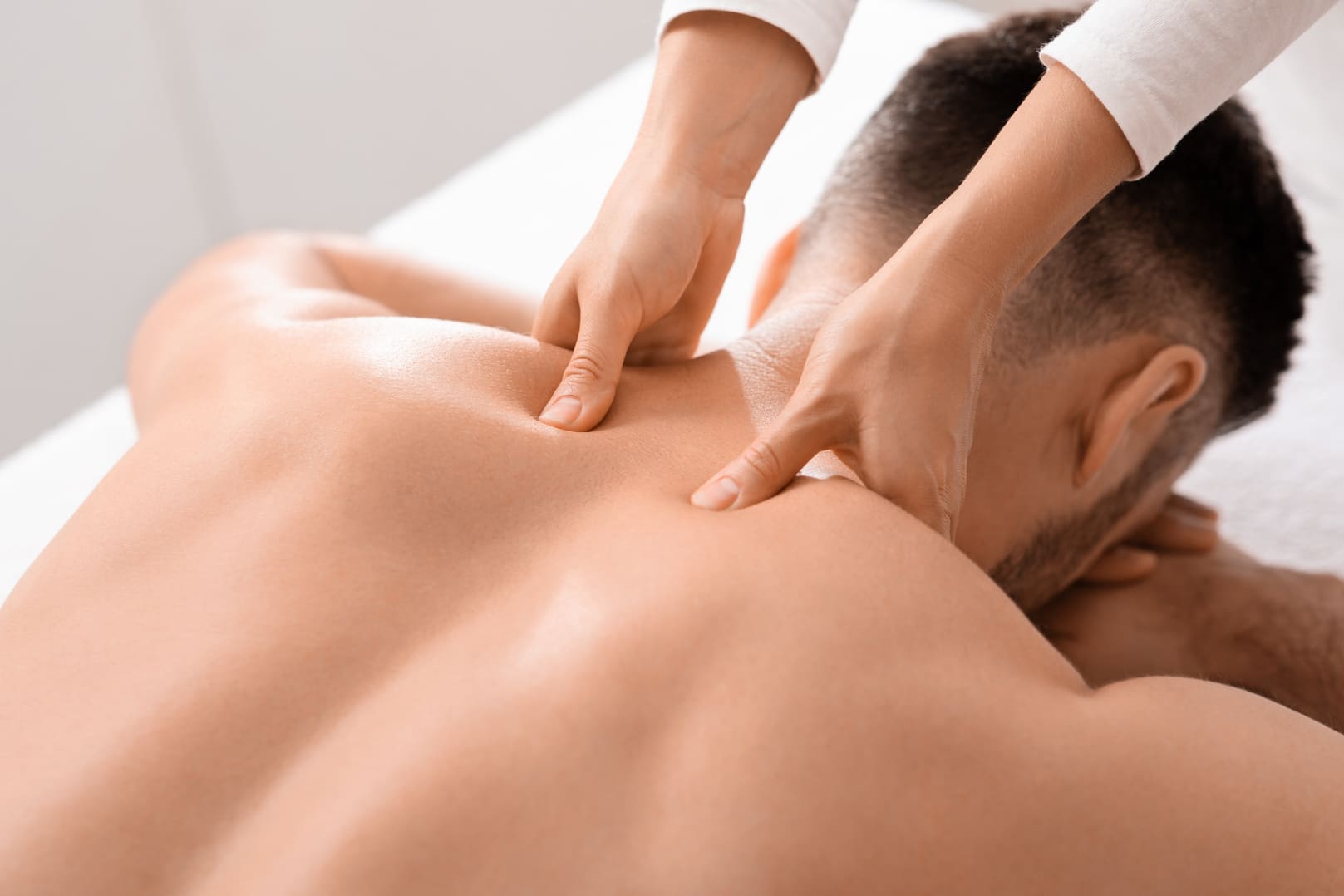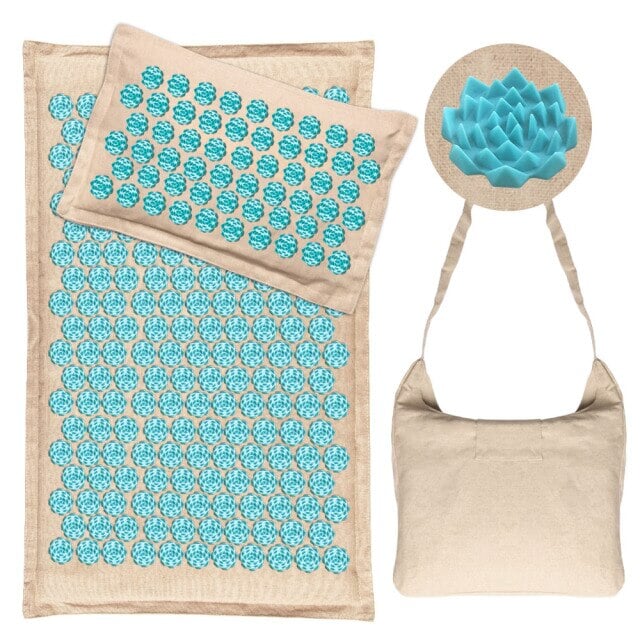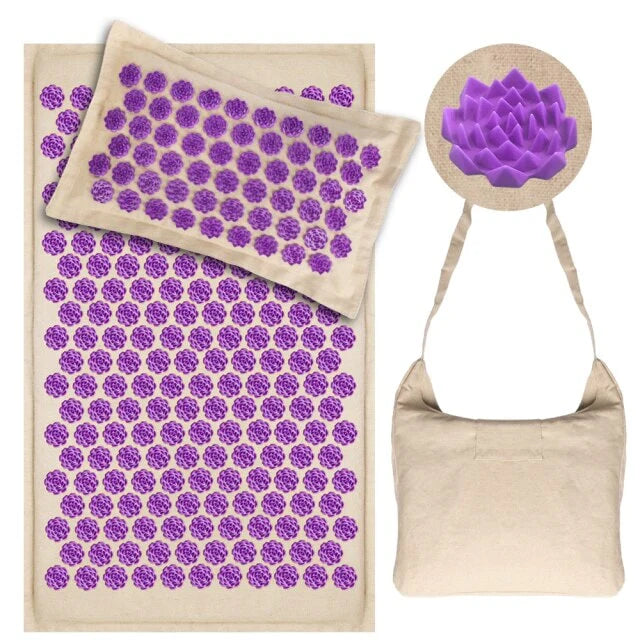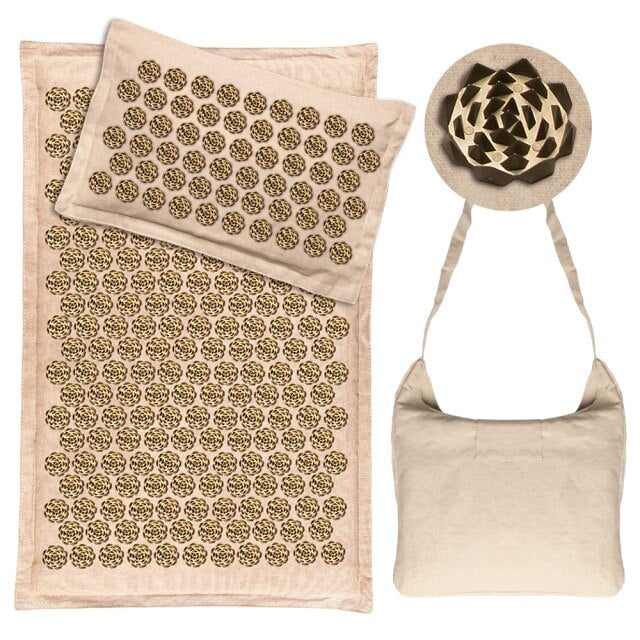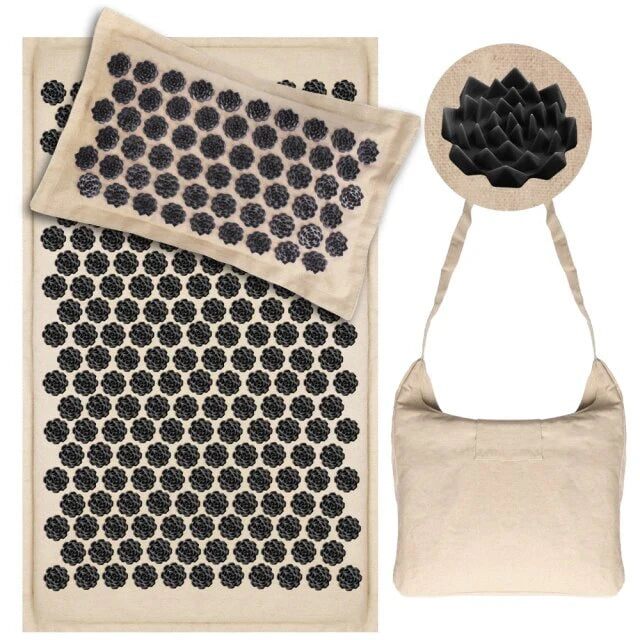La acupresión como terapia holística
La acupresión es una forma de tratamiento alternativo con raíces en la medicina tradicional china (MTC) , diseñada para estimular el flujo de energía a través de puntos específicos del cuerpo humano conocidos como “puntos de acupuntura”.
Esta forma de terapia se considera a menudo como un complemento a los tratamientos para diversos síntomas, como dolores de cabeza, náuseas e incluso dolores musculoesqueléticos, apoyando a quienes reciben atención médica.
Se trata de aplicar presión específica, a menudo con el pulgar, las yemas de los dedos o instrumentos especializados, a lo largo de los meridianos del cuerpo, que se cree que se conectan con los órganos e influyen en la salud general.
Los investigadores continúan explorando la eficacia de la acupresión para mejorar la calidad del sueño, reducir el dolor y aliviar los síntomas de afecciones como el cáncer, las náuseas relacionadas con la quimioterapia y las molestias laborales.
Entendiendo la acupresión: orígenes y evolución
Definición de acupresión
La acupresión es una terapia no invasiva que consiste en aplicar presión en puntos de acupuntura del cuerpo para equilibrar la energía corporal y aliviar los síntomas. Esta técnica puede ayudar a controlar las molestias mediante la estimulación de meridianos, afectando zonas asociadas con afecciones específicas como náuseas, vómitos e insomnio.
Se aplica presión con la mano, el pulgar o con un dispositivo de acupresión para ayudar a controlar los síntomas sin agujas, lo que lo convierte en una alternativa viable para quienes podrían evitar la acupuntura.
Antecedentes históricos y variaciones culturales
Originaria de la antigua China, la acupresión y terapias relacionadas, como el shiatsu y la reflexología, se han desarrollado en diversas culturas. Por ejemplo, la acupresión auricular , que se centra en el oído, ha demostrado potencial en ensayos clínicos como terapia alternativa para el manejo de síntomas, especialmente en pacientes con cáncer que experimentan efectos secundarios como insomnio y vómitos.
Los programas de medicina integrativa ahora suelen incluir la acupresión como terapia complementaria para el tratamiento de pacientes oncológicos. Las prácticas de medicina complementaria y alternativa se siguen adaptando, ofreciendo nuevas técnicas de acupresión para tratar diversos problemas de salud.
La ciencia detrás de la acupresión
¿Cómo funciona la acupresión?
La acupresión funciona estimulando los meridianos del cuerpo humano, por donde se cree que fluye la energía (qi). La técnica consiste en aplicar presión en los puntos de acupuntura para promover la relajación, aliviar el dolor y mejorar la calidad del sueño.
Al estimular puntos específicos, como los de la mano o la oreja, la acupresión puede estimular la liberación de endorfinas, reducir el cortisol y mejorar el flujo sanguíneo . Estudios clínicos, incluyendo ensayos controlados aleatorizados, han explorado la eficacia de la acupresión para controlar síntomas como náuseas, fatiga y dolor de cabeza.
Los resultados de la investigación, disponibles en bases de datos como Cochrane Database y Evid Based Complement Altern Med, indican que la acupresión es una herramienta valiosa para el alivio de los síntomas y el bienestar mental.
Beneficios basados en la investigación y la evidencia
Varias revisiones y estudios sistemáticos, incluidos ensayos controlados aleatorios, respaldan la eficacia de la acupresión para reducir el dolor, mejorar el sueño y aliviar las náuseas y los vómitos relacionados con la quimioterapia .
Por ejemplo, una revisión Cochrane destacó los posibles beneficios de la acupresión para pacientes con cáncer, en particular para reducir las náuseas sin los efectos secundarios asociados a los fármacos. Esta terapia basada en la evidencia, a menudo clasificada dentro de la medicina complementaria y alternativa, ayuda a mejorar la calidad de vida de los pacientes al abordar los síntomas físicos y mentales.
Artículos y estudios publicados en las revistas United States Patent y Chin Med destacan el lugar de la acupresión en la medicina integrativa moderna como una opción práctica y de bajo riesgo para los pacientes.
Tipos y formas de acupresión
Técnicas comunes de acupresión
Las técnicas de acupresión abarcan desde la presión manual con el pulgar y las yemas de los dedos hasta el uso de dispositivos de acupresión para una estimulación más profunda . Para afecciones como el dolor musculoesquelético y las cefaleas tensionales, los terapeutas capacitados suelen aplicar presión sostenida en los puntos de acupresión, mientras que los pacientes pueden usar bandas o semillas de acupresión para un alivio continuo.
En algunos casos, también se pueden utilizar dispositivos para aplicar presión precisa, como instrumentos de auriculoterapia para estimular puntos relacionados con náuseas o insomnio. Estos diversos métodos ofrecen flexibilidad para tratar diversas afecciones, ya sea como prácticas independientes o como terapias complementarias a la acupuntura o el masaje.
Formas de acupresión: diferenciando entre enfoques
Las diferentes formas de acupresión se centran en resultados terapéuticos únicos. Por ejemplo, la acupresión auricular, comúnmente conocida como acupresión auricular, se centra en puntos de la oreja para influir en los síntomas de todo el cuerpo.
La reflexología , otro enfoque, se centra en los puntos de acupuntura de los pies para tratar los órganos conectados a través de meridianos. Estudios sugieren que este tipo de acupresión puede reducir la presión arterial y mejorar los síntomas relacionados con el estrés.
A medida que más personas exploran terapias complementarias, la acupresión está ganando reconocimiento como una forma accesible y de bajo costo de manejo de síntomas que puede complementar los tratamientos médicos tradicionales.
Aplicaciones de la acupresión en la salud
Acupresión para el manejo del dolor y los dolores de cabeza.
La acupresión se utiliza frecuentemente para aliviar los síntomas del dolor crónico, como las cefaleas y las molestias relacionadas con la tensión. Pacientes con afecciones como las migrañas suelen encontrar alivio en el punto de acupresión He Gu (IG4) de la mano, que puede ayudar a aliviar la presión y reducir el dolor.
Los terapeutas de acupresión capacitados, a menudo afiliados a centros o clínicas de bienestar, realizan la acupresión como parte de un plan de tratamiento más amplio, en colaboración con profesionales médicos. Los pacientes refieren una sensación de relajación y alivio de los síntomas con la terapia de acupresión regular, lo que contribuye a un enfoque holístico para el manejo del dolor.
Acupresión para la salud de la mujer
La acupresión también es una opción popular para controlar los síntomas de salud femenina, como el dolor menstrual, las náuseas del embarazo y las molestias del parto . En ensayos clínicos, la acupresión ha demostrado su eficacia para reducir el dolor del parto al estimular puntos específicos.
Estas técnicas ofrecen una opción no invasiva para aliviar las molestias de forma natural, mejorando la experiencia de la paciente durante el parto. Terapeutas capacitados pueden aplicar presión en puntos como SP6 para aliviar los síntomas, lo que convierte a la acupresión en una valiosa herramienta para los programas de educación prenatal y la atención prenatal.
Acupresión en el bienestar digital y la salud mental
A medida que aumenta el tiempo frente a las pantallas, surgen aplicaciones de acupresión para el bienestar digital que abordan problemas como la fatiga visual y el estrés. Aplicar presión en puntos alrededor de las sienes o cerca de los ojos puede ayudar a los usuarios a aliviar la fatiga visual digital.
Las apps de bienestar ahora ofrecen sesiones guiadas de acupresión como parte de un programa más amplio de salud mental, utilizando sensores e indicaciones para garantizar una estimulación precisa. Esta novedosa aplicación destaca cómo la acupresión puede evolucionar para adaptarse a las necesidades de salud modernas , acortando la distancia entre las terapias tradicionales y los desafíos de salud contemporáneos.
¿Es segura la acupresión? Posibles efectos secundarios y precauciones
Seguridad y efectos secundarios
La acupresión se considera generalmente segura, aunque pueden presentarse efectos secundarios leves como dolor o fatiga. Para pacientes con afecciones específicas, como quienes reciben quimioterapia o controlan síntomas de cáncer , es fundamental consultar con un profesional médico antes de probar la acupresión, ya que es posible que deban evitarse ciertos puntos.
Estudios publicados en revistas como Complement Ther Med han destacado que la acupresión puede ser una terapia segura y accesible con riesgos mínimos. También existen dispositivos de acupresión para el autocuidado, pero se recomienda que los pacientes contacten con un terapeuta o profesional de la salud capacitado para obtener orientación inicial sobre su uso seguro.
¿Quién debe evitar la acupresión?
Si bien la acupresión es beneficiosa para muchas personas, ciertas personas, como aquellas con trastornos hemorrágicos o con riesgo de trombosis, deben usarla con precaución. Además, las mujeres embarazadas deben evitar estimular puntos de acupresión específicos relacionados con el parto, ya que podría inducir contracciones accidentalmente.
Los niños, los pacientes mayores y quienes padecen afecciones subyacentes también deben consultar con profesionales de la salud para obtener asesoramiento sobre su aplicación segura. En general, la acupresión es más adecuada como complemento que como sustituto de los tratamientos convencionales.
Consejos para empezar con la acupresión
¿Cómo prepararse para una sesión de acupresión?
Antes de una sesión, conviene prepararse manteniéndose hidratado, usando ropa cómoda y creando un ambiente tranquilo. Para las personas que reciben tratamiento por enfermedades crónicas, la acupresión puede ayudar a mejorar la relajación y la calidad de vida en general.
Muchos pacientes reportan una relajación inmediata después de una sesión, ya que la terapia fomenta un enfoque centrado y consciente hacia el bienestar . Quienes se inician en la acupresión pueden comenzar con técnicas suaves y aumentar gradualmente la presión a medida que se sienten más cómodos, aprendiendo con cada sesión.
¿Qué esperar de una sesión profesional?
En una sesión profesional de acupresión, los terapeutas pueden preguntar sobre síntomas, antecedentes médicos y afecciones actuales para adaptar la sesión. Acupresionistas capacitados evalúan a cada paciente individualmente y seleccionan los puntos de acupresión que mejor se adaptan a sus objetivos de salud.
Una sesión completa suele durar entre 30 y 60 minutos y puede abordar diversos síntomas, como problemas de sueño, náuseas o dolor musculoesquelético. Algunos centros ofrecen una experiencia integral, combinando acupresión con terapia de masaje u otros servicios complementarios para maximizar el alivio de los síntomas.
Preguntas frecuentes
1. ¿Qué es la acupresión y cómo funciona?
La acupresión es una terapia alternativa con raíces en la Medicina Tradicional China (MTC) que consiste en presionar puntos específicos, o acupuntos, en la piel para estimular el flujo de energía y promover la curación. Esta terapia actúa sobre los meridianos, canales por donde fluye la energía vital, llamada Qi.
Los profesionales aplican presión con los dedos o instrumentos especializados para actuar sobre puntos de acupuntura específicos, lo que puede ayudar a aliviar el dolor, reducir la ansiedad y mejorar la relajación. Los investigadores continúan estudiando los efectos de la acupresión, y los ensayos clínicos demuestran que puede beneficiar a los pacientes al reducir síntomas como náuseas, dolores de cabeza y estrés.
A diferencia de las agujas de acupuntura, que penetran la piel, la acupresión no es invasiva, lo que la hace accesible para quienes buscan métodos de tratamiento alternativos.
2. ¿Cuáles son los principales beneficios de la acupresión?
La acupresión ofrece diversos beneficios para la salud, como el alivio de síntomas como la ansiedad, el dolor de cabeza y el dolor crónico. Al presionar puntos específicos, esta terapia estimula la circulación, alivia la tensión muscular y promueve la relajación.
Las investigaciones indican que la acupresión puede ser especialmente beneficiosa para pacientes con enfermedades como el cáncer de mama, donde puede reducir las náuseas y la ansiedad asociadas con la quimioterapia.
La eficacia de la acupresión como servicio complementario para el manejo de afecciones está respaldada por estudios, donde los investigadores señalan que ayuda a mejorar la calidad de vida. Además, la acupresión es segura para la mayoría de las personas, incluidos los niños, ya que no es invasiva y se enfoca únicamente en la superficie de la piel.
3. ¿Cuáles son las diferentes formas de acupresión?
Existen diversas formas de acupresión, cada una dirigida a problemas y afecciones específicas. Entre los tipos más comunes se incluyen las técnicas inspiradas en la acupuntura china; el shiatsu, que utiliza una presión profunda y sostenida; la reflexología, que se centra en los pies; y la acupresión auricular, que aplica presión en puntos de la oreja.
Cada forma está diseñada para estimular diferentes puntos de acupresión, lo que ayuda a los pacientes a aliviar problemas como la ansiedad y el dolor. Los profesionales, capacitados en diversos métodos, determinan qué tipo de acupresión se adapta mejor a las necesidades específicas de cada persona . Si bien algunas formas pueden realizarse en casa, las afecciones complejas pueden beneficiarse de un servicio profesional, donde los profesionales utilizan técnicas de acupresión dirigidas a puntos específicos.
4. ¿En qué se diferencia la acupresión de la acupuntura?
Si bien la acupuntura y la acupresión se centran en estimular puntos de acupuntura y meridianos para tratar problemas de salud, difieren en su aplicación. La acupuntura consiste en insertar agujas en puntos específicos de la piel, mientras que la acupresión utiliza los dedos para aplicar presión sin dañar la piel.
Ambos métodos pueden ayudar a tratar afecciones como la ansiedad, los dolores de cabeza y el dolor muscular , pero la acupresión no es invasiva, lo que la hace ideal para quienes dudan en usar agujas. La acupuntura o la acupresión pueden ser beneficiosas, pero la naturaleza no invasiva de la acupresión permite a los pacientes autoadministrarse la terapia en casa o buscar la ayuda de un profesional capacitado, lo que amplía su accesibilidad.
5. ¿La acupresión es segura para todos?
La acupresión suele ser segura para la mayoría de las personas si se realiza correctamente, pero hay algunas consideraciones. Las personas con ciertas afecciones, como trastornos hemorrágicos o sensibilidad cutánea, deben consultar con un profesional de la salud antes de comenzar con la acupresión.
Si bien la acupresión es segura para niños, es fundamental que la realice un profesional capacitado para evitar una presión excesiva. Para quienes tienen inquietudes específicas, como pacientes con cáncer de mama, la acupresión puede ayudar a controlar los síntomas del tratamiento; sin embargo, es fundamental seguir las indicaciones de un profesional médico . En general, la acupresión es una opción eficaz y no invasiva que complementa las terapias tradicionales de forma segura.
6. ¿Puede la acupresión ayudar con los síntomas del tratamiento del cáncer?
Sí, la acupresión se utiliza a menudo como terapia complementaria para controlar los síntomas relacionados con el tratamiento del cáncer, especialmente en pacientes con cáncer de mama . Las investigaciones demuestran que la acupresión puede aliviar síntomas como náuseas, ansiedad y fatiga, mejorando así la calidad de vida en general.
Muchos pacientes sienten alivio de los síntomas al aplicar una presión suave en puntos de acupresión específicos, lo que reduce los efectos secundarios del tratamiento. Un estudio reciente de la Base de Datos Cochrane destacó la eficacia de la acupresión en pacientes con náuseas relacionadas con la quimioterapia.
La acupresión, combinada con terapias convencionales, ofrece un enfoque de apoyo al tratamiento del cáncer, mejorando el bienestar y ayudando a los pacientes a controlar los síntomas relacionados con el tratamiento.
7. ¿Cuánto tiempo se tarda en ver resultados de la acupresión?
Los resultados de la acupresión varían según la persona y su afección. Algunas personas experimentan un alivio inmediato de síntomas como la ansiedad y el dolor de cabeza, mientras que otras pueden requerir sesiones regulares durante días o semanas para notar una mejoría.
Los estudios sugieren que la acupresión constante puede ayudar a reducir los síntomas con el tiempo , especialmente en el tratamiento de enfermedades crónicas. Por ejemplo, los pacientes en tratamiento contra el cáncer pueden experimentar un alivio gradual de las náuseas y la ansiedad con la acupresión continua.
En general, la eficacia de la acupresión depende de la frecuencia y la duración de las sesiones, y muchos pacientes encuentran mayores beneficios con la práctica regular.
8. ¿Puedo hacer acupresión en casa o debo consultar a un profesional?
Existen muchas formas de acupresión que se pueden practicar en casa para tratar problemas como la ansiedad, la tensión o los dolores de cabeza. Al presionar puntos específicos del cuerpo, se puede estimular la relajación y aliviar los síntomas. Sin embargo, para afecciones más complejas o tratamientos personalizados, es recomendable consultar con un profesional cualificado.
Los profesionales saben qué puntos de acupresión tratar según los síntomas de la persona, lo que garantiza una experiencia más segura y eficaz. La acupresión en casa puede complementar las sesiones regulares con un terapeuta y permite a las personas controlar síntomas leves con comodidad.
9. ¿Cómo alivia la acupresión los dolores de cabeza y el dolor?
La acupresión alivia el dolor al actuar sobre puntos que conectan con las vías naturales de alivio del dolor del cuerpo. Al presionar puntos específicos, como el He Gu (IG4) en la mano, se estimula la circulación, se reduce la tensión muscular y se liberan endorfinas.
Estas respuestas fisiológicas ayudan a aliviar los síntomas de dolor de cabeza, dolor de cuello y ansiedad. Estudios indican que la acupresión ayuda a tratar el dolor crónico al mejorar el flujo sanguíneo y reducir la inflamación. La técnica es accesible y no invasiva, lo que la convierte en una excelente opción para quienes buscan un alivio natural del dolor.
10. ¿Qué debo esperar de una sesión de acupresión profesional?
En una sesión profesional de acupresión, un profesional capacitado hablará primero sobre sus problemas de salud, su estado de salud y sus objetivos. Determinará qué puntos de acupresión tratar según sus necesidades, como ansiedad, dolores de cabeza o manejo del dolor.
Puede sentir una relajación inmediata a medida que el terapeuta aplica presión con los dedos para estimular zonas específicas. Las sesiones suelen durar entre 30 y 60 minutos , y la mayoría de los pacientes refieren una sensación de alivio y relajación.
La acupresión es especialmente eficaz para controlar el estrés y la tensión física, ofreciendo una terapia integral y no invasiva para complementar los tratamientos médicos tradicionales.
